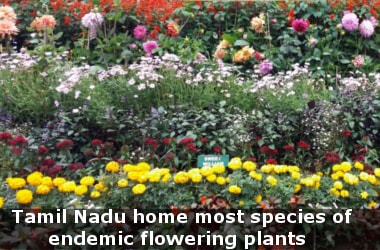Tamil Nadu- Home to most species of endemic flowering plants
Q. BSI announced that the highest species of endemic flowering plants are found in which southern India State?- Published on 04 Oct 16a. Kerala
b. Karnataka
c. Tamil Nadu
d. Andhra Pradesh
ANSWER: Tamil Nadu

Botanical Survey of India in the last week of Sept 2016 announced almost 1 in 4 flowering plant species in India are endemic to the country.
- Tamil Nadu has the highest number of species with 410
- Tamil Nadu is followed by Kerala with 357 and Maharashtra at 278
- According to scientific data in the currently released book, “Endemic Vascular Plants of India” of the 18259 flowering plants reported in the nation, 4003 are found only in India
- Regarding the geographical distribution of endemic plants, the Western Ghats tops the list with close to 2116 species followed by Eastern Himalayas with 466 species
- Close to 37 species of the black plum Syzygium or jamun are found along with 10 varieties of Musa or banana and 274 species of orchids found only in India
- Four different varieties of roses, 2 herbs and 2 climbers as well as 12 species of jasmine are found endemic to India
- When it comes to species, 45 species of the common black pepper family, 19 species of ginger and 13 species of cardamom were endemic to India
- 40 species of bamboo were also endemic to India
- Some endemic species were restricted only to certain parts of the country like the Nepenthes khasiana found in Khasi hills of Meghalaya
- Close to 58 genera of flowering plants were found endemic to India
- Publication also reveals that of 19365 vascular plants found in India, 4381 are endemic including 4303 angiosperms or flowering plants, 12 gymnosperms and 66 ferns and allied plants under the category of Pteridophytes
- Red sandal wood is found only in Southern parts of Eastern Ghats and is among the most widely exploited endemic plants in India
- This plant is identified as critically endangered under IUCN category